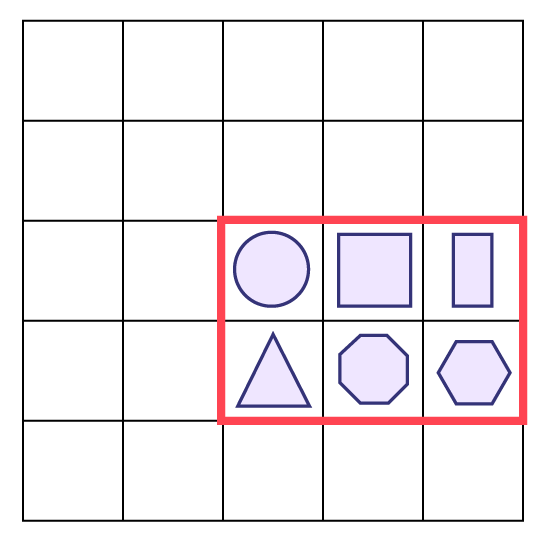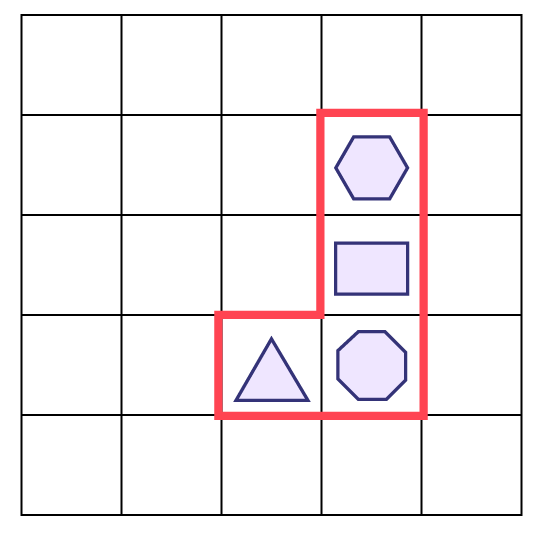E1. Geometric and Spatial Reasoning
Describe and represent shape, location, and movement by applying geometric properties and spatial relationships in order to navigate the world around them.
Learning Situation: Locate Me!
Total Duration: 2 hrs. 30 mins
|
Overall Expectation |
Specific Expectations |
|
E1. Geometric and Spatial Reasoning Describe and represent shape, location, and movement by applying geometric properties and spatial relationships in order to navigate the world around them. |
E1.4 Create and interpret simple maps of familiar places. E1.5 Describe the relative positions of several objects and the movements needed to get from one object to another. |
|
Learning Goals |
|
The purpose of this activity is to enable the student to use the expressions to the right of, to the left of, above, below, and between to describe the location of two-dimensional shapes. |
|
Learning Context |
Prerequisites |
|
Students will locate objects by giving their location in relation to other objects and to describe possible movements on a plane (for example, a checkers or chess board, a grid). |
To complete the activity, the student must be able to:
|
Materials
- examples of grids: checkers, calendars, hundreds chart (10×10 squares), grid paper
- Appendix 21.1
- Appendix 21.2
Mathematical Vocabulary
to the right of, to the left of, above, below, between, grid, cell, column, row
Before Learning (Warm-Up)
Show Appendix 2I.1.
Ask a student to point to a cell on the grid, a column of cells on the grid, and then a row of cells on the grid.
Then, ask the following questions:
- Can you identify a two-dimensional shape on the grid?
- How can you describe the location of the octagon? (Since the octagon is alone, point out that one must describe its location by counting the cells, rows, or columns.)
Draw a triangle in the square to the left of the octagon by saying, “I am drawing a triangle in the cell to the left of the octagon.”
Ask the question, “How can you describe the location of the octagon on the grid, now that we have added a triangle?”
Point out that when there is more than one shape, the location of one shape can be described in relation to the other.
Ask a student to draw a circle in the cell above the triangle.
Ask another student to describe the location of the circle in relation to the triangle.
Ask a student to draw a hexagon in the cell to the right of the octagon.
Ask another student to describe the location of the hexagon in relation to the octagon.
Ask a student to draw a rectangle in the cell above the hexagon.
Ask another student to describe the location of the rectangle in relation to the hexagon.
Ask a student to draw a square in the square above the octagon.
Ask another student to describe the position of the square:
- in relation to the octagon;
- in relation to the circle;
- in relation to the rectangle;
- in relation to the circle and the rectangle.
Trace the outline of the shape formed by the border of the two-dimensional shapes and ask the students to identify the mystery shape.
Example of a Response
 image A grid of 5 columns and 5 rows. There are 25 cells. In the third cell of the third column, there is a circle, in the cell below, there is a triangle. In the third cell of the fourth column, there is a square, in the cell below, there is an octagon. In the third cell of the fifth column, there is a rectangle, in the cell below, there is a hexagon. A red line forms a rectangle around the cells that have a shape.
image A grid of 5 columns and 5 rows. There are 25 cells. In the third cell of the third column, there is a circle, in the cell below, there is a triangle. In the third cell of the fourth column, there is a square, in the cell below, there is an octagon. In the third cell of the fifth column, there is a rectangle, in the cell below, there is a hexagon. A red line forms a rectangle around the cells that have a shape.
The mystery shape is a rectangle.
Active Learning (Exploration)
Provide a copy of Appendix 2I.2 to each student.
Provide the following instructions to students:
- Draw, on your grid, the outline of a mystery shape that contains four to six cells.
- The rectangle must be inside the mystery shape.
- Draw a two-dimensional shape in each cell.
Allow them the time needed to complete the task.
Circulate among the students and provide support as needed by asking questions. For example:
- What instruction can you give to your partner to place this shape?
- Do you have a shape that is between two shapes?
- Do you have a shape that is both above one shape and to the right of another?
- Can you add shapes so that you have a wider variety of instructions to give?
Form teams of two students and give each student another copy of Appendix 2I.2.
Explain that one student is giving directions for their partner to reproduce the patterns on the new grid and discover the mystery pattern.
Student instructions to partner:
- Draw a hexagon in the cell above the rectangle.
- Draw an octagon in the cell below the rectangle.
- Draw a triangle in the cell to the left of the octagon.
- Trace the outline of the figure formed by the border of two-dimensional shapes and identify the mystery shape.
Then, the other student proceeds in the same way to reveal their mystery shape.
Example of a Response
 image A grid of 5 columns and 5 rows. There are 25 cells. In the third cell of the third column, there is a circle, in the cell below, there is a triangle. In the third cell of the fourth column, there is a square, in the cell below, there is an octagon. In the third cell of the fifth column, there is a rectangle, in the cell below, there is a hexagon. A red line forms a rectangle around the cells that have a shape.
image A grid of 5 columns and 5 rows. There are 25 cells. In the third cell of the third column, there is a circle, in the cell below, there is a triangle. In the third cell of the fourth column, there is a square, in the cell below, there is an octagon. In the third cell of the fifth column, there is a rectangle, in the cell below, there is a hexagon. A red line forms a rectangle around the cells that have a shape.
The student's mystery shape is a hexagon.
Consolidation of Learning
Present Appendix 2I.1.
Have a student give instructions to a student on another team who will reproduce the shapes on the projected grid.
Ensure that the student uses specific phrases such as:
- in the cell to the right of ,
- in the cell to the left of ,
- in the cell above,
- in the cell below,
- between two shapes
- Ensure to accurately describe the location of each two-dimensional shape.
When students have found the mystery shape, ask questions such as:
- Which shape is to the right of...?
- Which shape is to the left of…?
- If a shape is to the right of one shape and to the left of another, what other expression can I use to describe its location?
- In what other situation can you use the word between to describe the location of a shape?
Leave copies of Appendices 2I.1 and 2I.2 in the math centre so that students can create additional mystery shapes and present them to the class.
Examples of Success Criteria
The student:
- accurately describes the position of the two-dimensional shapes;
- names the shape that is to the right, left, above or below another shape;
- name the shape that is between two shapes.
Differentiated Instruction
|
To Simplify the Task |
To Enrich the Task |
|
Reduce the size of the grid to be filled in or place more two-dimensional shapes in the grid. |
Increase the size of the grid to be filled in and require that all phrases be used in the instructions. |
Follow-Up at Home
Send the studied expressions to parents and ask them to use them in riddles or in guidelines.
Examples
- Tamara, could you name the utensil on the left side of the plate?
- Jean, would you bring me the towel that is under the blue towel?
Source: translated from Guide d’enseignement efficace des mathématiques de la 1re à la 3e année, Géométrie et sens de l'espace, p. 103-111.
